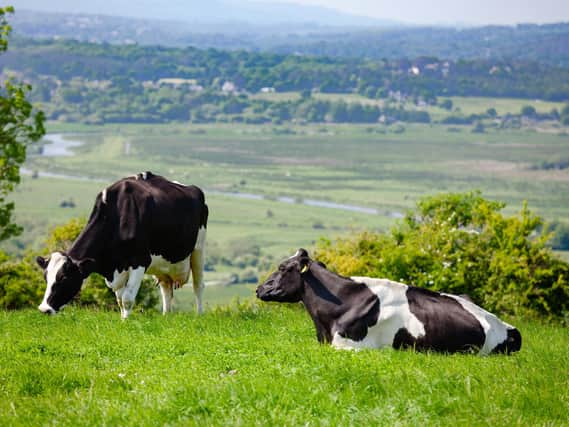Rates of bovine TB in North Yorkshire rose by 70 per cent in a year


Areas of England officially deemed at ‘low risk’ from bovine tuberculosis (TB) saw a 20% jump in the number of infected herds in the year to March.
The picture in North Yorkshire
In North Yorkshire, at the end of March 2020 just 0.27% of cattle herds were not TB free, and 34 animals were slaughtered due to TB in 2019/20.
Advertisement
Hide AdAdvertisement
Hide AdHowever by the end of March 2021, the percentage of cattle herd not TB free had risen to 0.47% with an eight-year high of 17 herds with TB.
In 2020/21 70 animals were slaughtered due to TB.
This means whilst the risk level in the county remains low, there has been a 70 per cent rise year on year in the number of herds with TB.
A spokesperson for the National Farmers’ Union said the disease “continues to devastate farming families across the country”.
The UK Government this month announced controversial badger culls would be extended to seven new parts of England.
Advertisement
Hide AdAdvertisement
Hide AdWhile these are planned for English counties with historically higher levels of bovine TB, the Government insisted it had “rigorous controls in place within low-risk areas”.
Bovine TB, which hit headlines this summer as the disease behind the case of Geronimo the alpaca, can be devastating for farmers’ livelihoods and costs taxpayers around £100m a year.
Transmission to humans is very rare but possible, for example through unpasteurised milk from an infected cow.
A vaccine for cattle is in development but is not expected to be rolled out until at least 2025.
Advertisement
Hide AdAdvertisement
Hide AdEfforts to identify and contain the disease differ in intensity depending on whether farms are in a low or high-risk area of the country.
Analysis of official figures shows that while the war against bovine TB may be being won in the hardest hit areas, the disease could be springing up elsewhere.
While the number of cattle herds struck by bovine TB in England’s high-risk areas fell by 2% in the year to March, they rose by 20% in those deemed low risk.
And it is part of a longer-term trend: in the past 20 years, the number of TB-hit herds in England’s low-risk areas has increased seven-fold, from 12 to 85.
‘This is a terrible disease’
Advertisement
Hide AdAdvertisement
Hide AdThe National Farmers’ Union said every part of the country would have its own unique challenges in the battle against bovine TB, which is why it was so important to have a strategy to work towards the complete eradication of the disease.
A spokesperson said: “Farmers are acutely aware of the need to do all they can to protect their herd from bovine TB.
“This includes regularly testing cattle, enhancing biosecurity on farm to prevent contact between wildlife and cattle, and cattle movement controls.
“This is a terrible disease which continues to devastate farming families across the country, causing huge strain emotionally, mentally and financially.”
Advertisement
Hide AdAdvertisement
Hide AdThe Department for Environment, Food and Rural Affairs (Defra) said the changes in infection rates in England’s low-risk areas were within the fluctuations they would expect to see from year to year.
A spokesperson said: “Bovine TB is one of the most difficult and intractable animal health challenges that the UK faces today, causing considerable trauma for farmers and costing taxpayers over £100 million every year.
“We have rigorous controls in place within low-risk areas such as mandatory post-movement testing of cattle moved into the low-risk areas from higher TB risk areas alongside more frequent annual surveillance testing of certain low-risk area herds.”
The spokesman said the Government was also accelerating elements of its bovine TB strategy, such as the development of the cattle vaccine, “so that we can eradicate this insidious disease as soon as possible”.
The alpaca which captured hearts
Advertisement
Hide AdAdvertisement
Hide AdBritain’s battle against bovine TB saw 37,835 cattle and 270 other livestock and pets slaughtered in 2020 alone.
Geronimo the alpaca was killed at the end of August after testing positive for bovine TB, despite a high-profile campaign to save its life.
The case sparked public protests and saw Geronimo become a household name.
Owner Helen Macdonald said on Wednesday that the alpaca did not have bovine TB at the time of its death, according to the initial findings of a post-mortem.
Her claim has been disputed by Defra.
Advertisement
Hide AdAdvertisement
Hide AdChief Veterinary Officer Dr Christine Middlemiss said: “We have completed the initial post-mortem examination of Geronimo.
“A number of TB-like lesions were found and in line with standard practice these are now undergoing further investigation.”
RSPCA brands badger culls ‘inhumane and ineffective’
Programmes to cull badgers - a protected species known to transmit the disease to cattle - have long drawn fierce debate.
Natural England’s announcement this week of culls in seven new areas of England provoked a furious reaction among animal rights organisations.
Advertisement
Hide AdAdvertisement
Hide AdFour of these culls will be in areas classed as ‘high risk’ while three will be in parts of the country bordering the worst affected zones, branded ‘edge’ areas.
A further 33 cull licences are to be extended, with the RSPCA saying up to 75,000 badgers could be shot this year.
Adam Grogan, of the charity, called the culls “inhumane and ineffective”.
He said: “It is appalling news that the cull is to be extended to another seven regions, given the Government's welcome announcement earlier this year that it would move away from culling towards badger vaccination, the development of cattle vaccination, more frequent and improved cattle testing, better management of cattle movements and incentives to improve biosecurity.
“Vaccination of cattle and badgers is key.”
The Government has already said no new culls will be licensed from 2022 onwards.